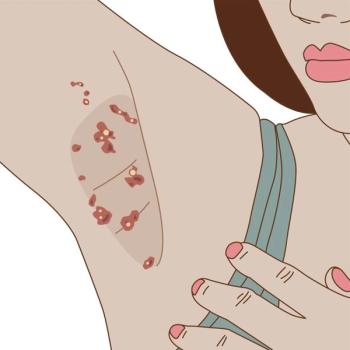
Oral Herpesvirus Infection With Impetigo Bullosa
For 3 days, a 5-month-old infant had a red, papular, nonpruritic rash around her mouth and vesicles on her hands. The child was being breast-fed by her mother, who had a similar rash around her nipple. The child was afebrile, and the physical examination revealed no abnormal findings. There was no history of allergy or change in diet.
For 3 days, a 5-month-old infant had a red, papular, nonpruritic rash around her mouth and vesicles on her hands. The child was being breast-fed by her mother, who had a similar rash around her nipple. The child was afebrile, and the physical examination revealed no abnormal findings. There was no history of allergy or change in diet. Culture of the perioral lesions and a Tzanck test were performed. Topical mupirocin was prescribed pending test results, and the mother was advised to feed her child from the other breast. Three days after the initial visit, the mother and child again presented for medical care. The perioral lesions had worsened and crusting had developed. The infant was still afebrile and systemic findings were normal. Bilal Chughtai, BA, and Jana Galan, MD, of North Shore University Hospital, Glen Cove, NY, write that the lesions had a honey-colored crust and vesicles characteristic of both herpesvirus infection and impetigo. Coxsackievirus A infection also was included in the differential diagnosis. The culture grew Staphylococcus aureus. The Tzanck test results demonstrated multinucleated giant cells consistent with herpesvirus infection. Cefadroxil and topical acyclovir were prescribed and the mother was advised to use a breast pump to feed the child until the lesions resolved. After one week, the lesions cleared without scarring on either the mother or child. Infection with herpes simplex virus (HSV) may lead to preferential bacterial attachment.1 It has been demonstrated that group A streptococci adhere to both cells infected with HSV type 1 and those infected with HSV type 2.2 For diagnosing skin lesions in children, the Tzanck test, Gram stain, and potassium hydroxide (KOH) preparation are the most important quick diagnostic tests.3 The Tzanck test is an easy, rapid, and sensitive test that can detect herpetic infection (with multinucleated giant cells) as well as noninfectious pustular eruptions (with eosinophils and neutrophils). The Gram stain and KOH preparation help rule out bacterial and fungal infections. 4 Use of these tests can spare a healthy infant with a benign transient condition an invasive evaluation for sepsis, potentially harmful antibiotic therapy and, possibly, from prolonged hospitalization with associated morbidity. Early recognition of a possible combined viral and bacterial infection ensures timely and adequate treatment.
Newsletter
Enhance your clinical practice with the Patient Care newsletter, offering the latest evidence-based guidelines, diagnostic insights, and treatment strategies for primary care physicians.


















































































































































































































































































